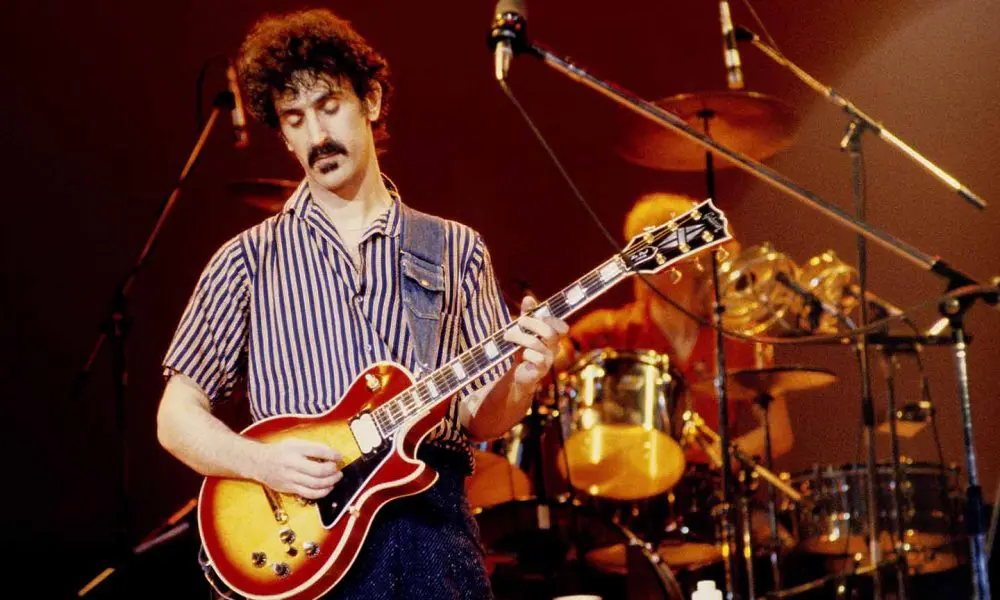The Innovative Ways Frank Zappa Used His Live Show Recordings
Despite huge advances in recording technology, it’s fair to say that no other major artist has used live recordings like Frank Zappa did.

There isn’t a Frank Zappa fan who hasn’t fantasized about spending time in the late composer’s vault. Back in 1979, when Zappa was installing a state-of-the-art recording studio – the Utility Muffin Research Kitchen – in his family home in Los Angeles, the composer created a large climate-controlled space to house his archive. Packed shelves of audio and visual tape boxes – some labeled, many not – ran from floor to ceiling, representing a lifetime devoted to composition and performance. As far as was possible, Frank Zappa recorded everything. Studio sessions, rehearsals, band members’ conversations, and – unusually, considering he began the process in the 1960s – recordings of live shows.
Zappa began recording and archiving the Mothers Of Invention’s adventures on the road from their earliest concerts. While these days, it’s commonplace for artists to record each of their shows, often with a view to later releases, back in the 60s, things were different – recording equipment and tape were expensive, difficult to transport, and few acts had the foresight to imagine that their shows would have value to future generations.
Listen to the best of Frank Zappa on Apple Music and Spotify.
Zappa, as was so often the case, thought differently. He developed a concept, which he referred to as the Project/Object – this meant that, as far as he was concerned, all of his albums, live shows, album covers, videos, and even interviews, were part of one large work. “Project/Object is a term I have used to describe the overall concept of my work in various mediums,” he wrote in his 1989 memoir The Real Frank Zappa Book. “Each project (in whatever realm), or interview connected to it, is part of a larger object, for which there is no ‘technical name.’ Think of the connecting material in the Project/Object this way: A novelist invents a character. If the character is a good one, he takes on a life of his own. Why should he get to go to only one party? He could pop up anytime in a future novel.”
There was no reason then, as far as Zappa was concerned, that a piece of his music – whether recorded in the studio or live on stage – shouldn’t be considered for use in future projects. Zappa increasingly thought of albums as collages. To him, his vast archives represented material that he could edit and fashion to suit his needs at any given time. It was vital then, that he had the best quality live recordings possible at his disposal.
Zappa’s earliest known recording can be found on the posthumous 1996 compilation The Lost Episodes. It’s a track called “Lost In A Whirlpool,” recorded in either December 1958 or January 1959 and featuring Zappa on lead guitar, his brother Bobby on rhythm, and Don Van Vliet (aka Captain Beefheart on vocals). It was recorded on a tape machine in a high school classroom. Zappa began recording in earnest, however, when he started working at Pal Recording Studio in Cucamonga, California, in the early 60s, honing his studio skills and experimenting with multi-track recording, editing, and tape manipulation. He took over the studio in 1964, renaming it Studio Z, and effectively worked round the clock on movie soundtracks and, mostly, his own compositions.
His recording apprenticeship served, Zappa began recording early Mothers Of Invention shows. In an interview published in EQ in 1994, Zappa recalled the early days of recording on the road, “We had eight microphones and an 8-track Shure mixer that was stuffed into a briefcase – and also a portable Uher recorder. A guy named Dick Kunc used to sit by the side of the stage with earphones on and try to get a balance while we were playing. On Weasels Ripped My Flesh, for example, there are several cuts that were done using that equipment. I’d say that was fairly primitive.”
Dick Kunc had recently landed a job as in-house engineer at Apostolic Studios, New York, when Zappa booked it out for sessions in July 1967. The following months were hugely productive, with much of We’re Only It For The Money, Lumpy Gravy, Uncle Meat, and Cruisin’ With Ruben And The Jets recorded. Kunc was a huge Mothers fan (listen to “The Dick Kunc Story” on The Lost Episodes for Kunc’s account of how he came to work with the band), which meant that he was more accommodating than most old-school engineers might have been of the unconventional, round-the-clock sessions.
Though Zappa had used field recordings before – see “Louie Louie (At The Royal Albert Hall In London,” “God Bless America (Live On Stage At The Whiskey A Go Go),” and “Ian Underwood Whips It Out (Live On Stage In Copenhagen)” from Uncle Meat – Kunc’s expertise and innovation meant that his on-the-road recordings were of higher quality and gave Zappa more material to play with. Volumes 1, 4 and 5 of Zappa’s late 80s series of live recordings, You Can’t Do That On Stage Anymore, feature Kunc’s handiwork, showing Zappa regarded the Mothers’ live performances as a vital part of his Project/Object.
After Kunc moved on, Zappa briefly reenlisted the help of engineer Bruce Margolis (“The Nancy & Mary Music” from Chunga’s Revenge was recorded live by Margolis), before settling on either Barry Keene or Kerry McNabb for much of his recordings over the 70s. Keene recorded a couple of June 1971 shows on a 4-track, before engineering the classic live album Fillmore East – June 1971 on a Fedco Remote 16-track studio. Keene went on to record many of Zappa’s 1972 shows with The Grand Wazoo Orchestra and The Petite Wazoo – some of his work can be heard on Imaginary Diseases (2006), Little Dots (2016) and Waka/Wazoo (2023), among others. McNabb’s standouts as a Zappa live recorder include the much-loved 1974 live album Roxy & Elsewhere (not to mention the whole run of Roxy shows released on 2018’s The Roxy Performances), Baby Snakes, and Bongo Fury, the document of Captain Beefheart’s stint on the road with the Mothers in April-May 1975.
Meanwhile, members of Zappa’s road crew, including Davey Moire, George Douglas and Klaus Wiedemann, also took responsibility for recording shows. These “road tapes” were more lo-fi, as Zappa explained in a 1987 interview with Guitar World, “I didn’t own a recording truck then, and all live concert tapes were being done on a Scully 4-track at 30 ips with Telefunken C-4D noise reduction. We were printing two stereo pairs taken ambiently with AKG stereo mics. Audible background hiss is the result of a whole stage full of amplifiers idling, combined with residual noise inherent in the recording.”
As technology became more sophisticated in the 80s, Zappa’s live recordings followed suit. In 1981, Zappa bought a remote recording truck (renamed the UMRK Mobile Studio) from Mike Love of The Beach Boys, who had apparently let it fall into disrepair. With the help of Mark Pinske, his go-to engineer from 1980-87, Zappa put the truck to good use. Interviewed for Mix in 2003, Pinske reflected on the freedom the recordings gave them, “The cool thing about doing the truck was, we came back and we had all these tapes that we could listen to, and then we could sort out good performances live, and edit together sections of a song.”
This is something that had interested Zappa as far back as the early 70s – in keeping with his Project/Object concept, he began using the live and studio takes of a song at his disposal to construct a version that suited him. Zappa told Rolling Stone in 1968, “All the material in the albums is organically related and if I had all the master tapes and I could take a razor blade and cut them apart and put it together again in a different order, it would still make one piece of music you could listen to. Then I could take the razor blade and cut it apart and reassemble it a different way, and it would still make sense. I could do this 20 ways.”
To Zappa, musicians were fallible, if he had a choice of multiple versions of a song, he could choose the parts that best satisfied him and edit them together. As he told Mojo in an interview conducted in 1993 and published the year after, “all the live stuff is edited, so l look for the best work that each musician can do, It’s not just a matter of cloying something together, I try and make the performance of each tune exemplary in some way. So I’m not just optimizing what I write, I’m optimizing what they improvise.”
This was painstaking work, reliant on a huge amount of skill and know-how, not to mention physical effort. But it was clearly something Zappa took pride in, as he told International Times in 1969, “It took me a long time to get used to handling a razor-blade like that. I just recently purchased my own machine that will enable me to do that work at home, and now I spend sometimes 10 or 11 hours in a row just sitting in front of that machine chopping tape up. ’Cos I really like to do it.” He’d later boast to Guitar Player about the number of edits on the 1982 track “Drowning Witch”: “Do you know how many edits there? Fifteen! That song is a basic track from 15 different cities. And some of the edits are two bars long.” Another extreme example is “Jesus Thinks You’re A Jerk” from the 1988 album, Broadway The Hard Way, which contains at least 21 edits and is taken from at least 11 concerts.
The quality and consistency of the live recordings that Zappa had access to allowed him to take the next logical step – taking parts from unrelated performances and juxtaposing them with one another. Zappa called this technique “xenochrony,” from the Greek words xeno (strange or alien) and chrono (time). As he explained, “In this technique, various tracks from unrelated sources are randomly synchronized with each other to make a final composition with rhythmic relationships unachievable by other means.” The most extreme example of this was on the 1979 album Joe’s Garage, on which Zappa claimed every guitar solo was taken from an unrelated live track apart from “Watermelon In Easter Hay.” The guitar solo on “On The Bus” was an edit of an “Inca Roads” solo given a new home on a studio backing track, while “Packard Goose” featured a Zappa guitar solo taken from at least two sources, including a take on “Easy Meat.”
Despite huge advances in recording technology, it’s fair to say that no other major artist has used live recordings like Frank Zappa did. By recording just about every note he and his bands played, he effectively created an archive that he could draw upon to sample himself. His unique worldview, his quest for perfection, and his punishing work ethic led him to push music forward as fast as the technology he was using allowed. It’s almost impossible to imagine what he’d do nowadays.
Listen to the best of Frank Zappa on Apple Music and Spotify.














